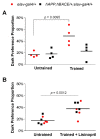The Angiotensin-Converting Enzyme Inhibitor Lisinopril Mitigates Memory and Motor Deficits in a Drosophila Model of Alzheimer's Disease
- PMID: 35366264
- PMCID: PMC8830455
- DOI: 10.3390/pathophysiology28020020
The Angiotensin-Converting Enzyme Inhibitor Lisinopril Mitigates Memory and Motor Deficits in a Drosophila Model of Alzheimer's Disease
Abstract
The use of angiotensin-converting enzyme inhibitors (ACEis) has been reported to reduce symptoms of cognitive decline in patients with Alzheimer’s disease (AD). Yet, the protective role of ACEis against AD symptoms is still controversial. Here, we aimed at determining whether oral treatment with the ACEi lisinopril has beneficial effects on cognitive and physical functions in a Drosophila melanogaster model of AD that overexpresses the human amyloid precursor protein and the human β-site APP-cleaving enzyme in neurons. We found a significant impairment in learning and memory as well as in climbing ability in young AD flies compared to control flies. After evaluation of the kynurenine pathway of tryptophan metabolism, we also found that AD flies displayed a >30-fold increase in the levels of the neurotoxic 3-hydroxykynurenine (3-HK) in their heads. Furthermore, compared to control flies, AD flies had significantly higher levels of the reactive oxygen species (ROS) hydrogen peroxide in their muscle-enriched thoraces. Lisinopril significantly improved deficits in learning and memory and climbing ability in AD flies. The positive impact of lisinopril on physical function might be, in part, explained by a significant reduction in ROS levels in the thoraces of the lisinopril-fed AD flies. However, lisinopril did not affect the levels of 3-HK. In conclusion, our findings provide novel and relevant insights into the therapeutic potential of ACEis in a preclinical AD model.
Keywords: Alzheimer’s disease; Drosophila; aging; angiotensin-converting enzyme inhibitors; kynurenine pathway of tryptophan metabolism.
Conflict of interest statement
The authors declare no conflict of interest.
Figures




References
-
- Rocca W.A., Petersen R.C., Knopman D.S., Hebert L.E., Evans D.A., Hall K.S., Gao S., Unverzagt F.W., Langa K.M., Larson E.B., et al. Trends in the incidence and prevalence of Alzheimer’s disease, dementia, and cognitive impairment in the United States. Alzheimer’s Dement. 2011;7:80–93. doi: 10.1016/j.jalz.2010.11.002. - DOI - PMC - PubMed
Grants and funding
LinkOut - more resources
Full Text Sources
Molecular Biology Databases
